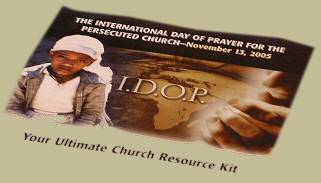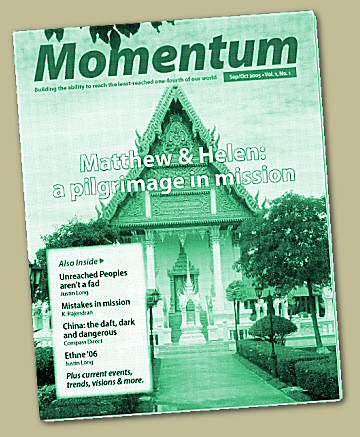 Go to NEWSLETTER BACK ISSUES
Go to NEWSLETTER BACK ISSUESGo to ARTICLE INDEX
Load Acrobat Version
"But I say to you, love your enemies and pray for those who persecute you." (Matthew 5:44)
The REVEILLE EQUIPPER Third/Fourth Quarter 2005, Vol. 9 No. 3
- Feature: Roots of G.W.O.T. Are in Internal Conflict
- News: President Names Enemy
- News: Characteristics of World's Largest Churches
- Area Profile: Dagestan: Al-Qaida Hunts New Home
- Opportunity: Earthquake Relief in Pakistan
- Opportunity: International Day of Prayer for the Persecuted Church
- Resource: A Parable in Bosnian and English
- Resource: Momentum: Web Based Magazine
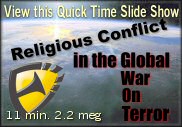

Feature:
Roots of Global War On Terror Lie in Internal Conflict
by Dr. Bruce Sidebotham

Have you ever stood too close to a dog fight and gotten bit? Ever try to break up a fist fight and get slugged?
Human tendency to weight our own problems heavier than others' makes discovering the roots of terrorism difficult. In the Global War on Terror (GWOT), we take more credit than we deserve. Some say America is to blame and others expect America to solve the problem. In reality we are just spectators standing too close to a vicious brawl.
Western and Muslim civilizations have been at odds for generations, at times even trying to annihilate each other. This time we are witnessing and experiencing the collateral damage from a Muslim civilization that is trying to annihilate parts of itself.
Where are most people dying in the GWOT? Is it in conflict between Muslims and non-Muslims or is it between factions of Muslims themselves?
In Iraq and Afghanistan, the blood spilled from American soldiers pales in comparison to blood that Iraqis and Afghans are spilling from each other. From Morocco to Indonesia, many more Muslims are dying from conflict with other Muslims than from conflict with Christians.
Even in Sudan where a Christian south has been fighting for independence from a Muslim north, the conflict was not recognized as rising to the level of genocide until Muslims began fighting each other in Darfur province.
Unfortunately, ethnicity obscures our ability to perceive what is really going on. We see Kurds pitted against Arabs in Iraq, Tajiks and Uzbeks (Northern Alliance) allied against Pushtun (Taliban) in Afghanistan, and black skinned tribes struggling against Arabs in Sudan. Note, however, the common presence of religious conflict in all of these ethnic ones.
Religious affiliations mobilize combatants much like the English and Germans rallied to Protestantism while the Spanish and French rallied to Catholicism in nationalistic wars that racked seventeenth century Europe.
We can better understand violence within Islam by investigating some of our own differences within Christianity.
The main theological issue driving conflict in Islam today is essentially the same controversy that has divided modernist and fundamentalist Christians for the past century.
 Fundamentalist and modernist Christians can be differentiated by many criteria, but the one which applies equally to Muslims relates to principles for interpreting divinely inspired texts.
Fundamentalist and modernist Christians can be differentiated by many criteria, but the one which applies equally to Muslims relates to principles for interpreting divinely inspired texts.
Fundamentalists vest their scriptures with great authority. They take them at face value and interpret them literally in all instances except those where a figurative meaning is blatantly obvious.
Modernists are more skeptical. They treat their scriptures more as literature than as divine law. They prefer allegorical and figurative applications.
Everyone knows the Christmas story. Jesus was born of a virgin, wrapped in swaddling clothes, placed in a manger, visited by shepherds and wisemen, then was taken to Egypt to escape King Herod. So how do fundamentalists and modernists respectively interpret this story?
For fundamentalists the Christmas story as recorded in the gospels is true history. However, Dr. Frederickson of Boston University was quoted in the Washington Post on 22 December 2001 in an article titled "The Story of Jesus' Birth Revised" as saying, "I can't think of any New Testament scholar who takes [the gospel account of Jesus' birth] to be historically reliable."
The same article quotes Dr. Markus Borg of Oregon State University saying, "The truth of these stories is not dependent on their historical factuality . . . the truth lies in their use of such universal metaphors as light in darkness, waking from sleep, the coming of the dawn."
According to the Washington Post, modernists who are able to see beyond the literal language to the deeper literary meanings are the true scholarly Christians. To the fundamentalist, however, men like Dr. Borg and Dr. Frederickson cannot even be considered to be Christians.
Fundamentalist Christians find divine authority in their scriptures for all kinds of social positions like definitions for human life, marriage, and sexuality.
Modernists using "scholarship" make these same scriptures accommodate a variety of social positions as being "Christian."
So how does this principle of interpretation divide Islam? Let us look at how different Muslims interpret a passage on Jihad.
Muhammed Pickthall's translation of Qur'an Surah 9:5 says, "Then, when the sacred months have passed, slay the idolaters wherever ye find them, and take them (captive), and besiege them, and prepare for them each ambush, But if they repent and establish worship and pay the poor-due, then leave them their way free. Lo! Allah is Forgiving and merciful."
About this idea of slaying the non-believers unless they repent, Al-Muhajiroun issued a press release that was readable on their web site (www.al-muhajiroun.f2s.com) on 16 September 2001. It said, "The Taleban are Muslims working for the establishment of Shari'ah, and Muslims in the East and West therefore have an obligation to support them. . . . O Muslims, stand together and unite to fight . . . the book of Allah calls you, and paradise awaits you."
On 21 November 2001, in an article titled "The Distortion of Islam," the national newspaper of the Muslim country of Bangladesh, The Independent, proclaimed about this exact same verse, "The commandment to "slay the pagans wherever you find them" in verse 9:5 speaks of hostile Arab tribes surrounding Medina . . . When sincere scholarship and exegesis is applied, it becomes quite clear that verse 9:5 is one of self-defense and not a carte blanche to kill all non-believers."
The same newspaper ran an editorial on 18 September 2001 in which Zahidul Hague asserted, "I don't think any Islamic country can support such sort of terrorism because Islam itself is a religion of peace."
How can both be correct?
The truth is that Islam is a religion at war within itself. On one side are the fundamentalists adhering to the literal meaning and authoritative application of their divinely inspired scriptures. On the other side are the modernists who use "sincere scholarship" to interpret the Qur'an according to their definition of true religion.
Between the modernist Muslims and modernist Christians is very little difference. Of such it can be said that they worship the same god -- the god of modern scholarship which takes authority over the literal words of their respective texts.
Between fundamentalist Muslims and Christians we also find some striking similarities. Both ascribe divine authority to literal interpretations. Both are battling against modernists for public influence. But these cannot be said to worship the same God.
The gods and methods of fundamentalist Christians and Muslims differ greatly because their sacred texts are very different. On one hand the Apostle Paul admonishes, "If the unbeliever leaves, let him do so" (1Cor 7:15), while Mohammed tells his people to "Slay the unbelievers" (Surah 9:5).
Without reins of power, fundamentalist Christians fight against modernist ideology in the press and in courtrooms with arguments. Similarly cut off from political dominance, fundamentalist Muslims resort to terrorism against even their own people.
Terrorism may have become a global menace, but its roots go deep into Muslim sectarian conflict. America can take many steps to enhance its security, but only one long term solution gets to the root of the problem. Since it is the fundamentalist faction of Islam that promotes terrorism, only reformation of fundamentalist Islam or conversion of fundamentalist Muslims will end their terrorism.
Belief systems come and belief systems go and sometimes they subtly change. A few of them manage to hang around for thousands of years. Fundamentalist Islam is one belief system whose time has definitely come to pass or change
News:
President Names Enemy
by Patrick Goodenough, International Editor CNSNews.com
 President George W. Bush clearly identified the enemy for the first time in a speech he delivered on 6 October 2005.
President George W. Bush clearly identified the enemy for the first time in a speech he delivered on 6 October 2005.
So say a number of conservative commentators reacting online to the president's speech, in which he spoke of the ideology behind Islamist terror and attempts to create a "radical Islamic empire."
More than four years after 9/11, and after the "global war on terror phrase was briefly sidelined by some administration officials in favor of the "global struggle against violent extremism," Bush on Thursday chose a new and more specific emphasis.
"Some call this evil Islamic radicalism; others, militant Jihadism; still others, Islamo-fascism," he said in a speech at the National Endowment for Democracy.
Bush, in fact, used the phrase "Islamic radicalism" another half dozen times during the speech.
He likened Islamic radicalism to earlier failed ideologies, primarily communism, and accused Iran and Syria of collaborating with terrorists, warning that the U.S. "makes no distinction between those who commit acts of terror and those who support and harbor them."
He also referred, without using the term, to Islamists' vision of setting up a "caliphate" under Islamic law.
"The militants believe that controlling one country will rally the Muslim masses, enabling them to overthrow all moderate governments in the region, and establish a radical Islamic empire that spans from Spain to Indonesia," he said.
Many commentators in recent years, both supporters and opponents of the Bush administration, have criticized the notion of fighting a war against something as abstract as "terrorism," calling the phrase meaningless, vague, or a politically-correct euphemism designed to avoid offending Muslims.
The term "Islamic radicalism" was welcomed by many of these commentators as a clearer and more specific definition of the enemy.
"Finally, four years after the bloodiest Jihadi attack on the Western Hemisphere, and perhaps worldwide, the President of the United States named the enemy," said Walid Phares, a terrorism expert and professor of Middle East studies. "He used the 'ism' word."
Phares, who was born and raised in Lebanon, recalled urging Bush in a letter last year to "name the ideology behind the terrorists."
"Americans are not fighting nor being targeted by an abstract called terrorism, but a growing body of ideological concepts," Phares said at the time. "They need to know what is it they are up against."
"At long last, Bush has identified the enemy," wrote Marc Shulman in a post on the weblog Israpundit, adding that "this speech represents progress for those of us who have become sick and tired of having the politically-correct word 'terrorists' used to describe our enemy."
Glenn Reynolds on Instapundit said of the speech: "Notable features - besides its overall clarity - are the naming of Iran and Syria, and his willingness to talk about a war against Islamic terror, not just generic 'terror.'"
"There was still quite a bit of political eggshell- walking, but this marks the first time that Bush has identified and described the real goals of radical Islam – to re-establish the mythical caliphate and the global dominance of Islam," commented Charles Johnson on Little Green Footballs.
"For the first time that I know of, the President has spoken openly about the jihadists' dream of establishing the caliphate," wrote Islamic specialist and author Robert Spencer on his weblog, Jihad Watch. "He still spent a lot of time in his speech talking about peaceful Islam, but this is nevertheless a step orward toward reality."
Liberal commentators were as quick to criticize Bush's speech, which Marc Cooper, a contributing editor to The Nation, thought "went over like a Mars bar in the diabetes ward."
"Tired and over-used themes," was the verdict of the Comments from Left Field blog.
"The guy just can't let some themes go," it said. "He yet again evokes the memories of 9/11, throws a little terror politik in there with some WMDs."
Writing in Village Voice, liberal journalist Laura Rozen described Bush's speech as "Churchillian mimicry" and said it remained to be seen whether it could "staunch the growing grumbling of his base."
Read the Full Speech at:
www.whitehouse.gov/news/releases/2005/10/20051006-3.htmlSubscribe to the free CNS News Daily E-Brief at:
www.CNSNews.com
News:
World's Largest Churches Reveal Trends
by Wolfgang Simson
used with permission from FridayFax
 Even though influence is more important than size taking a look at the attendance of the world's largest churches gives an impression of developments in recent years. Much is changing. Churches which had an attendance of 300,000 a decade ago, such as 'Ondas del Luz y Amor' in Buenos Aires, now have "only" 70,000. Completely new models are popping up, such as the Indian University which became a church, regularly seeing 80,000 people attending.
Even though influence is more important than size taking a look at the attendance of the world's largest churches gives an impression of developments in recent years. Much is changing. Churches which had an attendance of 300,000 a decade ago, such as 'Ondas del Luz y Amor' in Buenos Aires, now have "only" 70,000. Completely new models are popping up, such as the Indian University which became a church, regularly seeing 80,000 people attending.
The membership of mega-churches fluctuates strongly, so the numbers here are the attendance, not members.
Yonggi Cho's church in Seoul claims a membership of 773,000, but an attendance of "only" 253,000 in the main church and the main satellites.
What is church?
One trend which is growing stronger is that the church is starting to see itself differently. It is no longer understood as a single, organized fellowship (with a pastor, a building, a program, and a more-or-less creative name), but as an organic community of Christians in towns and regions, the sum of the members of related house churches, cells, groups, and fellowships. This gives the church, as in the times of Acts, a regional instead of denominational identity. "The church in Corinth," Ephesus, Antioch, or Jerusalem corresponds today to "the church in Berlin," Boulder, Beijing, or Brasilia.
Regional house church networks are replacing mega-churches.
Such regional churches are not led by a "Senior Pastor," but by regional teams, generally formed by the coalescing of the five-fold ministry. It is very noticeable that the traditional pastoral ministry tends not to play the key role, but, rather, people with an apostolic or prophetic gifting, as hinted at in 1 Corinthians 12:28 and Ephesians 2:20. Christian community and unity is formed by belonging to the same region or town; unity is lived out in networked house churches and large celebrations, or at least in leaders' meetings in places where Christians are heavily persecuted.
One of the smaller (!) house church networks in southern China has an attendance of 400,000; larger networks number several million. The twenty largest regional (not national) house church networks in China, Vietnam, and northern India would completely change the list of largest churches below.
For security reasons, we cannot publish any names or other details, with the exception of V. Choudhrie in India, because most, if not all, such large, regional house church networks exist in nations which persecute or repress Christians. They generally belong to the group which missiologist Prof. David Barrett calls "Crypto-Christians" – underground Christianity.
We believe that there are around twenty regional house church networks around the globe with an attendance of over 250,000. Hence, the list below starts with the world's previously largest known church – the Yoido Full Gospel Church, ranked 21st.
Which are trend-setting nations?
These developments started outside the West (North America, Europe, Australia, and New Zealand), so many Western pastors and Christian leaders find them difficult to take seriously. Many still understand the West to be the center of Christianity, as in 1700, from which missionaries are sent out to complete the Great Commission.
Traditionally, the USA, Britain, or Germany have been the trend-setting nations in the Church. That is where the influential publishing houses have their headquarters and where the vast majority of conference speakers, authors, and seminary professors come from. It seems that many are asking, "What good thing can come out of Vietnam, India or Nicaragua? And yet exactly these and other non-Western nations are home to the most important trends in Christian activity. Are we paying attention?
What about the USA?
Up until recently, mega-churches were a typically American phenomenon. It is striking, then, that not one of the world's forty largest churches is in the USA or another Western nation. The really significant church growth is taking place basically outside the West.
The Washington Post recently published a study by church researcher, John N. Vaughn, revealing 840 mega-churches in the USA, with a weekly attendance of over 2,000 (figures of 23 May 04).
The top five American churches by average attendance are:
- 1. Lakewood Church, Houston, TX (25,060)
- 2. World Changers, College Park, GA (23,093)
- 3. Saddleback Community Church, Lake Forrest, CA (20,100)
- 4. The Potters House, Dallas, TX (18,500)
- 5. Fellowship Church, Grapevine, TX (18,129)
- 21. Yoido Full Gospel Church, Seoul, Korea (253,000)
- 22. Works and Mission Baptist Church, Abidjan, Ivory Coast (150,000)
- 23. Yotabeche Methodist P. Church, Santiago, Chile (150,000)
- 24. Mision Carismatica Internacional, Bogotá, Colombia (150,000)
- 25. Deeper Life Bible Church, Lagos, Nigeria (120,000)
- 26. Elim Church, San Salvador, El Salvador (117,000)
- 27. Nambu Full Gospel, Seoul, Korea (110,000)
- 28. AOG Grace and Truth, Kyanggi-do, Korea (105,000)
- 29. Kum Ran Methodist, Seoul, Korea (80,000)
- 30. Vision de Futuro, Santa Fe, Argentina (70,000)
- 30. Ondas del Luz, Buenos Aires, Argentina (70,000)
- 32. Young Nak Presbyterian Church, S. Korea (60,000)
- 33. Winners Chapel, Ota, Nigeria (50,000)
- 34. Yesu Darbar, Allahabad Agricultural Institute, India (40,000- 80,000)
- 35. Soong Eui Methodist, Inchon, Korea (47,000)
- 36. Ministeria La Cosecha, San Pedro Sula, Honduras (35,000)
- 37. Chattisgarh/Madhya Pradesh House Church Network, India (30,000)
Area Profile:
Dagestan - Al Qaida's Latest Target for New Bases
by Elizabeth Kendal, from WEA Religious Liberty News and Analysis
e-mail: Religious-Liberty(at)xc.org
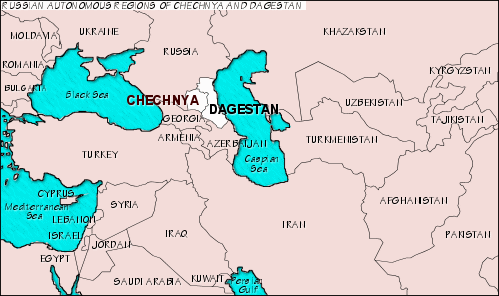
In January this year Islamic jihadists launched a fresh offensive aimed at drawing Dagestan, a southern republic of Russia between Chechnya and the Caspian Sea, into the jihad (Islamic holy war) for the Caucasus. Unlike the militaristic Chechen jihadist incursion into Dagestan of August 1999, this recent offensive has been a guerrilla-style terror campaign.
According to a July 2005 report by the Russian Academy of Sciences, there were 70 Islamic terror attacks in Dagestan in the first six months of 2005, compared with 30 for all of 2004. The attacks, which are becoming more sophisticated and deadly, primarily target Russian soldiers and Dagestan's police and government officials.
Sources indicate that as many as 2,000 Islamic insurgents, many belonging to the Al Qaeda-linked Jamaat Sharia, are involved in the insurgency. Sergei Markov, a Kremlin adviser, recently told the Christian Science Monitor, "Our forces have captured or killed citizens of 52 countries operating with the terrorists in the north Caucasus. The enemy brings an ideology of radical Islam that seeks political power through terrorist methods."
"'We are no longer talking about Chechen secessionists challenging Moscow,' says Mr. Markov. 'Now it's radical religious ideologues who aim to destroy the unbelievers and establish an Islamic caliphate.'"[1]
Around 11 September, the Islamist "Kavkaz Centre" (Caucasus Centre) published on its website a press release from Jamaat Dagestan Sharia.[2]
After a string of murders and assassinations, Jamaat Sharia has claimed "legitimate power" in Dagestan. In its press release, Jamaat Sharia protests that the "law of kafirs" has destroyed the "law of sharia" in Dagestan, enabling a kafir state to be built upon the blood of their ancestors.
Jamaat Sharia labels those who protect the "kafir state" as "kafir" and "gun meat,"and commands that they "repent before Supreme and Almighty Allah, to leave your kafir and the dog service, and for the sake of own blessing to accept the Islam and to [come under the] protection of religion of Allah!!! All that who on amnesty has left the kafir and slavish work, has repented and has accepted the Islam, we promise after a victory and establishments of laws of Sharia to employ in Islamic Army. The victory is close!!! To Allah Akbar!!!"
However, along with this promise of amnesty for those who desert the "kafir" and turn to Islam (i.e. submit to Jamaat Sharia and its Wahhabi/orthodox creed) is the warning that the amnesty will expire at the end of September. This would be just in time for a jihadist Ramadan offensive.
Dagestan was annexed by Russia in 1813 and became an autonomous republic in 1920. Christianity was introduced by Armenians and Georgians in the 6th Century. One of Dagestan's most famous buildings, the Juma Mosque, is a converted 6th Century Christian basilica. Today around nine percent of the population is ethnic Russian, and around ten percent of the population is Christian. The main tension within Dagestan is not between Christians and Muslims (who are mostly traditional Sufi) but between the majority Muslims and the aggressive, pro-jihad, pro-sharia, Wahabbi minority.
Most of the Wahhabi jihadists in Dagestan draw their inspiration from the Afghan mujahideen who fought the Russians through the 1980s. Chechen leader Shamil Basaev and many others fighting the jihad for the Caucasus received their training in Afghanistan.
With around 34 ethnicities and 29 languages (mostly mutually unintelligible), Dagestan is the most diverse region in all of Russia. Dagestan is not an ethnic name but rather it simply means "land of mountains" in Turkish.
Dagestan is nominally ruled by a State Council that includes representatives of the 14 main ethnic groups. Unfortunately, since the break up of the Soviet Union the real power in Dagestan has been with the State Council Chairman, Magomedali Magomedov, a representative of the former Soviet Union, who is backed by Putin but not the people, and who symbolizes extreme corruption.
If anything, the dissatisfaction Dagestanis have with the ruling powers can only be of benefit to the Wahhabi jihadists, as recruitment to Wahhabism and jihad is so much easier amongst disaffected Muslims in search of poverty relief and regime change.
This is not the first time in recent history that jihadists have attempted to capture Dagestan. In August 1999 jihadists from Chechnya staged an incursion into Dagestan and declared Dagestan to be an Islamic State. However, they were quickly repelled by Russian forces backed by local militias. This year's guerrilla terror has been quiet enough to slip under the radar, yet significant enough to do real damage, and horrific enough to instill fear. There are two main reasons why Dagestan is important for the jihadis.
1) Terrain: Dagestan is a land of mountains, making it a good base for Islamic terrorists and a difficult place for Russia's mechanized forces.
2) History: Andrei Smirnov notes, "During the 19th century Caucasus war, Dagestan and Chechnya formed an almost united front against the invading Russian army. The residents of the territory now encompassing the two republics formed an Islamic state called 'Imamate,' which was able to confront Russia effectively for decades, until its leader, Imam Shamil, surrendered to Russian General Alexander Baryatinsky in 1859. Knowing this shared history quite well, the separatist leaders of Chechnya repeatedly tried to drag the people of Dagestan into their struggle for independence."[3]
Smirnov continues, "Despite the failure of his 1999 venture and the redeployment of Russian troops to Chechnya in 2000, Shamil Basaev did not stop his attempts to move the war eastward, beyond the Chechen borders. Specifically, he initiated a very careful, and very slow process of preparing Dagestan for guerrilla warfare. The hundreds of militants from Dagestan who had joined Basaev's group in the mid-1990s made this process much easier to organize. A Dagestan field commander, Rabbani Khalilov, became the leader of the Dagestani mujahideen."
The jihad in the Caucasus not only threatens religious liberty, but it also threatens to turn the Caucasus into a terrorist haven.
If jihadists can control the Caucasus mountains and Dagestan, then they can replace the mujahideen training camps of Afghanistan and threaten "moderate" and "secular" Muslim communities around the world. The Caucasus would become a major base for training and deploying jihadis, just as Afghanistan was under bin Laden and the Taliban through the 1990s.
Jamaat Sharia gave the people of Dagestan until the end of September to repent and submit. With eight months of terror that include a string of strategic murders and assassinations behind them, the threat declared, and Ramadan underway, the January 2005 words of Andrei Smirnov reverberate louder than ever, ". . . Dagestan is now nearer detonation than ever before."
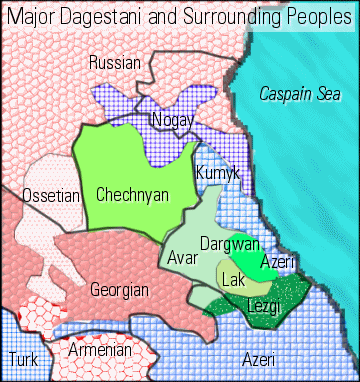
| E T H N I C I T I E S O F D A G E S T A N | |
| people group | percent |
| C A U C A S I A N P E O P L E S (70%) | |
| Avar | 28% |
| Dargin | 16% |
| Lezgin | 12% |
| Lak | 5% |
| Tabasaran | 4% |
| Chechen | 3% |
| Rutul | 1% |
| Agul | 1% |
| Tsakur | <1% |
| T U R K I C P E O P L E S (19%) | |
| Kumyk | 13% |
| Azeri | 4% |
| Nogay | 2% |
| O T H E R P E O P L E S (11%) | |
| Russian | 9% |
| Tat | 1% |
| Ukrainian | 1% |
| Tartar | <1% |
| Ossetian | <1% |
| half a dozen others | <1% |
| data from en.Wikipedia.org | |
NOTES:
1) "Russia sees Global Jihad on Southern Flank" by Fred Weir, 25 July 2005
www.csmonitor.com/2005/0725/p07s01-woeu.html
and "Secret Sects Threatening to Put a Match to Tinderbox Republic" from Sebastian Smith in Makhachkala, Russia, 19 July 2005
www.timesonline.co.uk/article/0,,3-1699086,00.html
2) Kavkaz Centre publishes Jamaat's press release "Sharia" without reductions
kavkazcenter.com/eng/content/2005/09/13/4068.shtml
and "Radical Islamic Group Names Itself Legitimate Authority of Russia's Dagestan" 11 September 2005
www.mosnews.com/news/2005/09/11/dagestanpower.shtml
3) "Dagestan's Insurgents Regroup As New 'Sharia Jamaat' Organization" by Andrei Smirnov, Eurasia Daily Monitor, 19 January 2005
jamestown.org/edm/article.php?article_id=2369112
Opportunity:
Earthquake Relief in Pakistan
A terrible earthquake has caused massive devastation in the Kashmir area of Pakistan, India, and also parts of Afghanistan. This is the worst natural disaster to have hit Pakistan in recorded history. The present death toll as of 18 October stood at over 50,000 and was expected to go higher. The United Nations estimates more than 4 million people have been affected by the earthquake, and 1.5 million homes have been destroyed.
Kashmir is one of the most unreached areas in the world, with a tiny fraction of one percent of its inhabitants being Christians. Furthermore, this part of Pakistan has been home to an insurgency that destabilizes Pakistan and seeks to annex the Indian portion of Kashmir to Pakistan so that the Muslims there will not be under secular and Hindu non-Muslim government. Relief efforts here are important to global security.
| SOME SPECIALIZED ORGANIZATIONS DOING DISASTER RELIEF IN PAKISTAN | |
| oganization | contact information |
| Asia Harvest |
1903 60th Place, Ste. M1204, Bradenton, FL 34203 www.asiaharvest.org office(at)asiaharvest.org |
| Christian Aid Mission |
PO Box 9037, Charlottesville, VA 22906 1-800-977-5650 www.christianaid.org" friends(at)christianaid.org |
| Jubiliee Campaign |
9689-C Main St., Fairfax, VA 22031 1-877-654-4331 |
| Open Doors |
PO Box 27001, Santa Ana, CA 92799 1-888-524-2535 www.opendoorsusa.org usa@odusa.org |
| Voice of the Martyrs |
PO Box 54, Caney, KS 67333 1-800-747-0085 www.persecution.com thevoice(at)vom-usa.org |
Opportunity:
International Day of Prayer for the Persecuted Church
I.D.O.P.
13 November 2005
Resource:
Parabola O Jednom Mostu
A Parable in Bosnian and English
Barbara Farah teaches English to speakers of other languages. Many of her students were refugees from Bosnia and Croatia who described the destruction of their homeland and the ancient Stari Most bridge. Barbara's conversations with her students and her own travels to Mostar inspired this story. Parable of the Bridge tells about a beautiful bridge built by a kind king who wishes to communicate with his people. When an imposter tries to defame the king, the bridge is destroyed and a temporary bridge is built. The death of the king's ambassador paves the way for a permanent bridge to be built.
Resource:
MOMENTUM Web Based Magazine
Momentum is a new web-based publication designed to help believers impact the least-reached 27% of the world. Senior Editor Justin Long desires to build six things in its readers:
- Drive:
a passion to head quickly down the path to the least-reached peoples of the world - Energy:
a capacity to bring the Gospel across barriers of culture, language or location - Effort:
actions that lead to evangelism, church planting, and societal transformation - Inspiration:
an ability to recruit the unmotivated and unmobilized into the movement -
Power:
increased effectiveness through self-discipline, accountability and unwavering focus -
Strength:
to resist outside forces that would sway us from the task of frontier mission.
